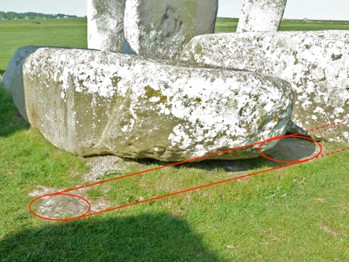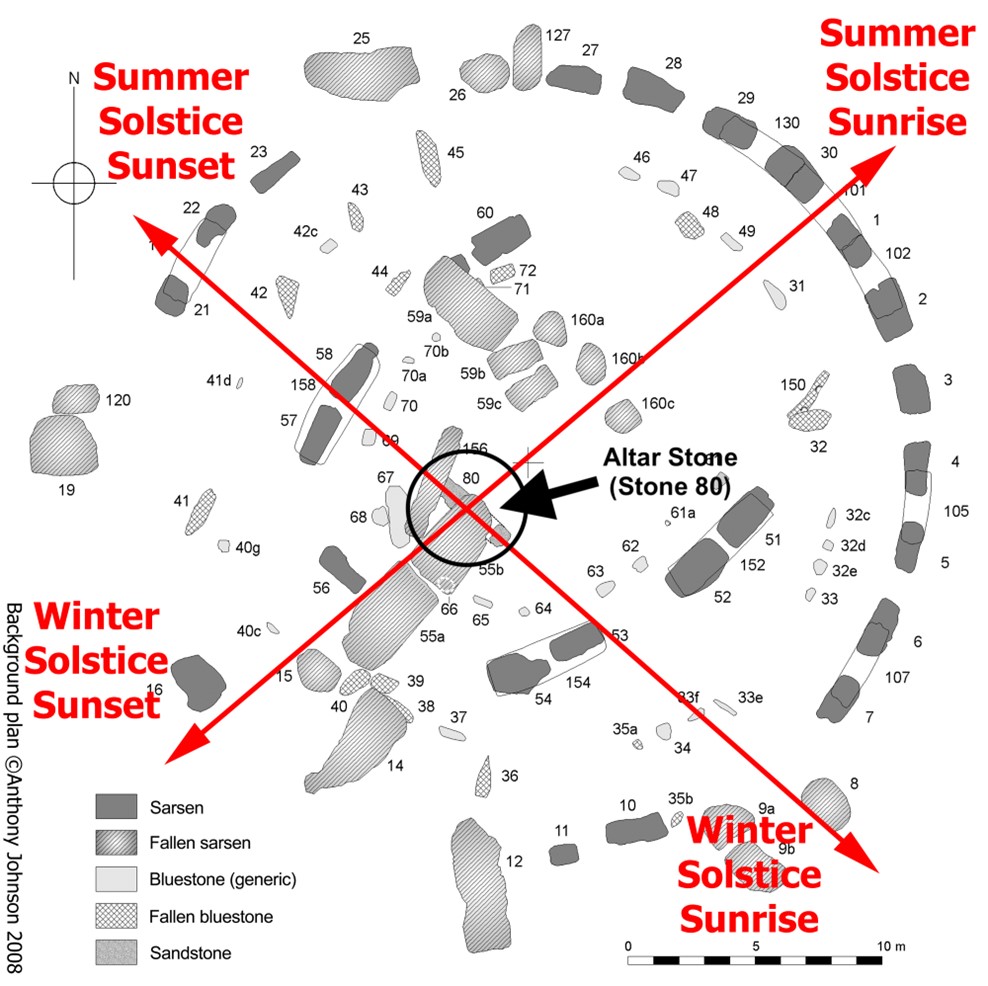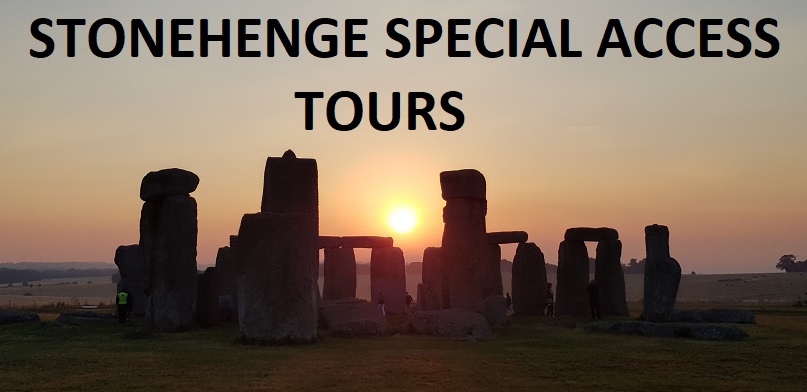Altared States: The Altar Stone at Stonehenge is one of the most mysterious of the 900 tons of rock that has been deliberately brought to the site by humans over the last 5000 years.
It sits inside the stone circle in a very special position – lying prone, mostly buried in the turf, directly in front of what was once the tallest trilithon on the site of which only a single stone still stands, the slim and elegant Stone 56.
It’s tricky to see as it’s mostly obscured by the collapsed upright and lintel of that tallest trilithon, but this image shows the eastern half of it highlighted in red – the dotted lines indicate that it continues off-picture to the right.
The primary axis of the monument – from Summer Solstice Sunrise to Winter Solstice Sunset – crosses directly over the centre of the Altar Stone, and the secondary axis – from Winter Solstice Sunrise to Summer Solstice Sunset – runs down the midline of this 16’ long x 3’ 6” wide x 1’ 9” deep lump of fine grained greenish sandstone. It therefore lies precisely on the intersection of the main solar alignments at Stonehenge.
It has always been recognised that the Altar Stone is a “foreign” stone, that it is not a locally-sourced sarsen.
For over a century it had been grouped with the bluestones that originate in the Preseli Hills of Pembrokeshire in south west Wales but – being a sandstone rather than a dolerite or rhyolite – its likely source was thought to be the Cosheston Beds of Old Red Sandstone near Milford Haven.
The suggestion was that it had been collected along the supposed coastal route that the bluestones were assumed to have taken.
However…
As recently as 2020, detailed analysis revealed that the unique Altar Stone didn’t closely match the Cosheston Beds mineralogy. This led to its provenance changing to a possible source in the Bannau Brycheiniog (Brecon Beacons) in south east Wales – the formation known as the Senni Beds – just north of Abergavenny.
This was particularly interesting because it bolstered the idea that the bluestones had been transported to Stonehenge by a land route rather than being rafted by sea around the coast.
The story didn’t stop there. Further analysis revealed another wrinkle – the Altar Stone has a very high level of barium, much higher than the samples extracted from the Anglo-Welsh basin for comparison. The historical linking of the Altar Stone and bluestones as “foreign” stones had biased researchers towards looking for a South Wales source for it, and the evidence was now pointing a different way.
In 2023, via a paper entitled “The Stonehenge Altar Stone was probably not sourced from the Old Red Sandstone of the Anglo-Welsh Basin: Time to broaden our geographic and stratigraphic horizons?” (https://doi.org/10.1016/j.jasrep.2023.104215) Ixer, Pearce, Bevins et al dropped a bombshell.
Looking at the geological map of Britain, there are only a few possible sources of an Old Red Sandstone with such high levels of baryte cement – the West Midlands, the north of England and… Orkney.
It is far too early to know whether this last possibility is in fact true, but there are established links in the archaeology between Orkney and Stonehenge and it’s an intriguing idea that the Altar Stone may conceivably have made a 500+ mile journey. We expect exciting news this week, you heard here 1st!
GUEST BLOGGER: SIMON BANTON
RELEVANT LINKS:
New mystery over origins of Stonehenge after remarkable discovery – THE GUARDIAN
100-year-old origin theory of Stonehenge’s iconic Altar Stone could be wrong, scientists say – LIVE SCIENCE
Tours of Stonehenge with local guided experts – STONEHENGE GUIDED TOURS
Analyze This: Stonehenge’s ‘Altar Stone’ has mysterious origins – SCIENCE NEWS
Stonehenge Guided Landscape Tours – STONEHENGE TOUR COMPANY
Stonehenge Altar Stone is probably not from Wales – THE PAST
The Stonehenge News Blog
Follow us on Twitter and Facebook for all the latest Stonehenge News and Equinox updates.
http://www.Stonehenge.News
















